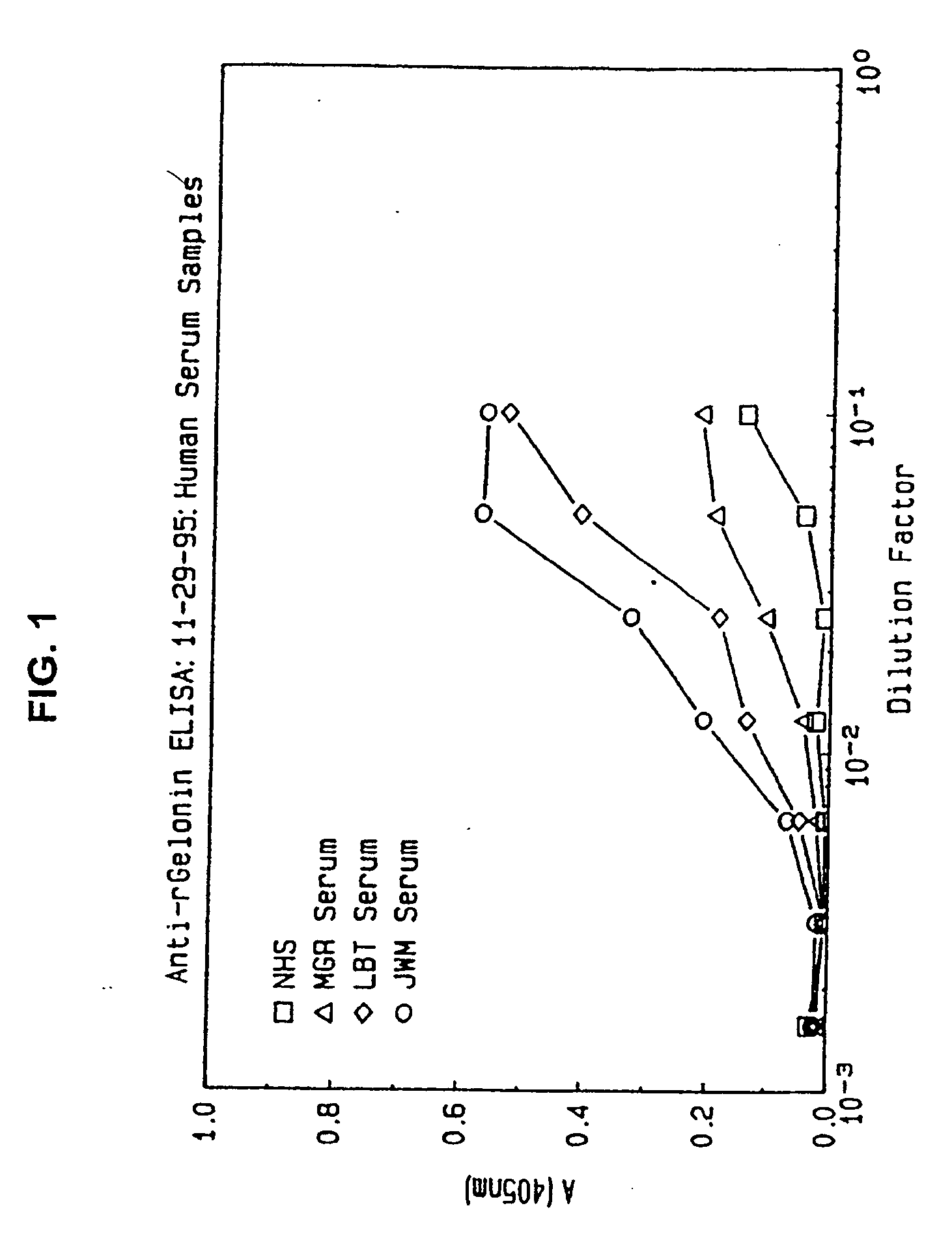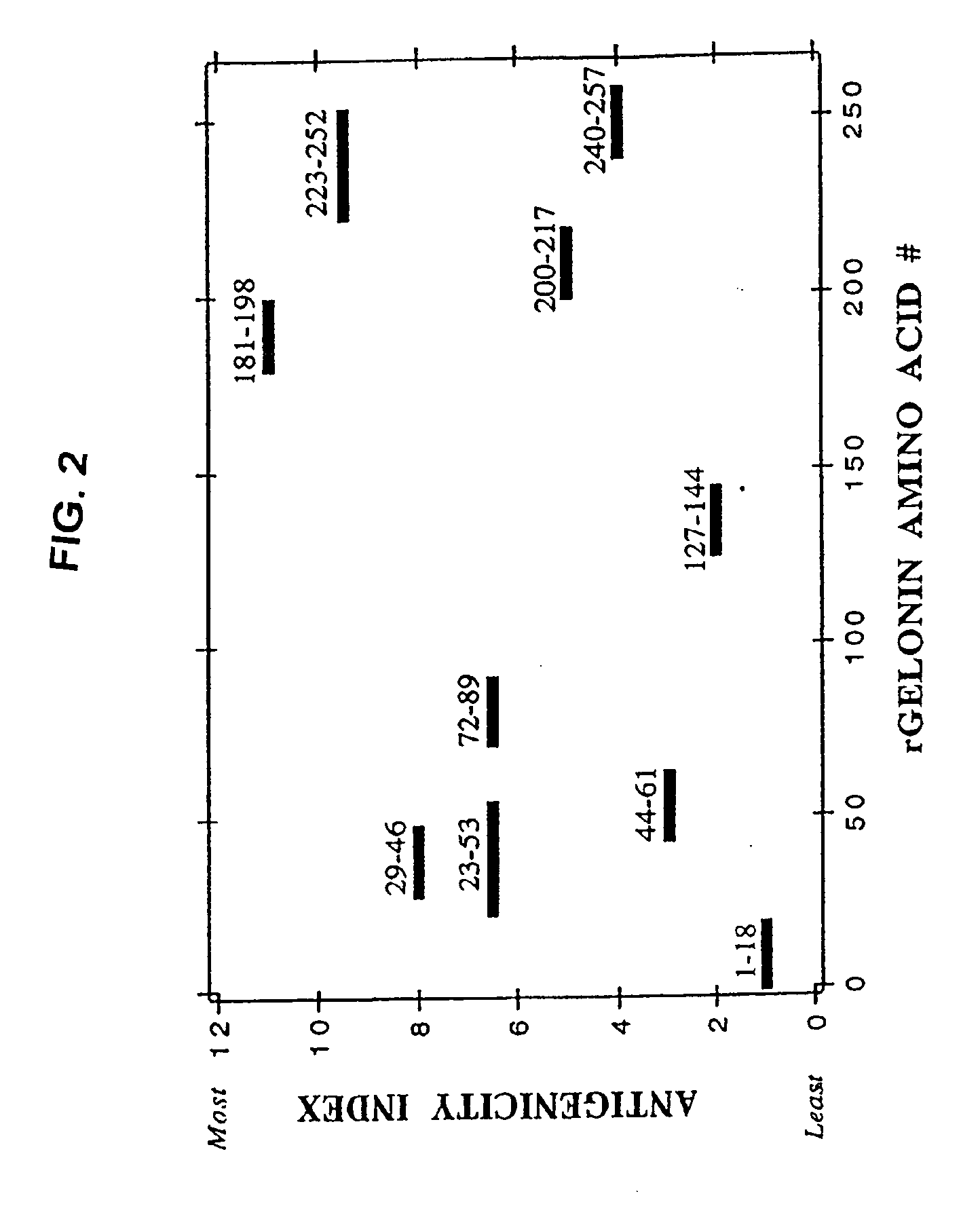Modified proteins, designer toxins, and methods of making thereof
a technology of modified proteins and designer toxins, applied in the field of molecular biology and toxicology, can solve the problems of eliciting an immune response, heterogeneity of target antigen expression, and narrowing of the therapy window of approximately 14 days
- Summary
- Abstract
- Description
- Claims
- Application Information
AI Technical Summary
Benefits of technology
Problems solved by technology
Method used
Image
Examples
example 1
Sequential Deletion Studies
[0433] The nucleotide sequence encoding recombinant gelonin (SEQ ID NO:2) was utilized as the template to create these toxins. Sequence analysis and structural modeling of rGel showed a significant folding of the molecule into pleated sheets, beta coils, and hairpin loops as shown. According to these studies, amino acids 200-277 (C-terminal) appear to fold into a binding pocket similar to that of the docking port of RTA for its B chain. Since rGel has no B chain, this “docking port” was theorized to be a vestigial portion of the toxin and may be unnecessary to the biological activity of this protein.
[0434] Sequential deletion mutants of the cDNA molecule encoding rGel from the C-terminal and from the N-terminal were created as shown in FIG. 3A and 3B and Table 7 and designated CFR1901-CFR1905. In preliminary studies, constructs CFR 1904, 1905, 2001, 2007, and 2024 demonstrated detectable activity in Rabbit Reticulocyte Lysate Assays (RRLA). These constru...
example 2
Map Antipenic Linear Peptide Domains
[0440] Antigenic domains on the rgel molecule have not been previously described in the literature. The antigenic domains of the rgel molecule can depend on either the carbohydrate or the peptide sequences of the molecule. Recombinant rGel produced in bacteria has no protein glycosylation, and therefore, antibodies directed against rGel should recognize peptide domains on the molecule.
[0441] In order to identify antigenic domains on the rGel molecule, human polyclonal antibodies were first isolated from the serum of laboratory workers occupationally exposed to recombinant gelonin. Serum obtained from three laboratory workers was added to 96-well ELISA plates coated with rGel. The plates were then developed using anti-human antibodies to identify the presence of human anti-gelonin antibodies. Serum from two of the three workers showed significant antibody titers compared to that of the control human serum (FIG. 1). Twenty ml of serum from these t...
example 3
Replacement of Antigenic Sequences with Human Sequences
[0443] Human / plant chimeric molecule were designed utilizing the information regarding antigenic domains obtained using human anti-gelonin antibodies above to identify four specific antigenic domains in the gelonin molecule ( amino acids 205-257, 23-42, 71-88 and 189-204). These sequences were further analyzed using the GenQuest / BLAST database to search for homologies to known human proteins. An additional consideration in this study was to not only identify a “human” homologous sequence, but also to align such a sequence in the designed toxin molecule so that the enzymatic(n-glycosidic) functionality of the resulting hybrid molecule can be preserved.
[0444] Four candidate sequences for insertion into the designer toxin were identified from the database and which were used as the basis for amino acid changes (Table 8). Human homologous sequences for Domain 1 showed a high homology (40%) to human KELL protein, which is a blood g...
PUM
| Property | Measurement | Unit |
|---|---|---|
| temperatures | aaaaa | aaaaa |
| temperatures | aaaaa | aaaaa |
| temperatures | aaaaa | aaaaa |
Abstract
Description
Claims
Application Information
 Login to View More
Login to View More - R&D
- Intellectual Property
- Life Sciences
- Materials
- Tech Scout
- Unparalleled Data Quality
- Higher Quality Content
- 60% Fewer Hallucinations
Browse by: Latest US Patents, China's latest patents, Technical Efficacy Thesaurus, Application Domain, Technology Topic, Popular Technical Reports.
© 2025 PatSnap. All rights reserved.Legal|Privacy policy|Modern Slavery Act Transparency Statement|Sitemap|About US| Contact US: help@patsnap.com



